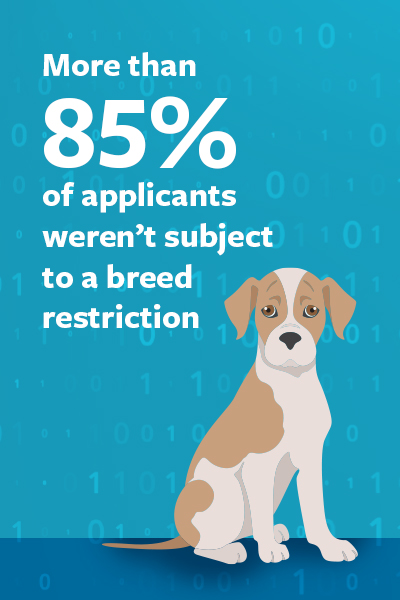How adopter data helps us serve animals
Make smart choices with the right data to boost adoptions and tailor community outreach

Maybe you hear the word “data” and feel the headache coming on. Or maybe you’re an Excel pro who dreams in pivot tables. Really, it doesn’t matter. Anyone working at an animal shelter or rescue can ask themselves this question: Are we making smart choices based on the right data?
And anyone can learn a lot from Michael Morefield about how to answer that.
When the coronavirus turned shelter operations upside down in March 2020, Morefield was the director of marketing and communications at the Arizona Animal Welfare League in Phoenix. (He now leads marketing for Altered Tails, a nonprofit spay and neuter clinic.) As the AAWL shifted from walk-ins to appointment-only adoptions, he convinced his coworkers to move from pen-and-paper forms to online questionnaires – enabling him to start gathering data from the answers.
A year later, he’s still amazed by what he learned.
AAWL is a limited-admission shelter that takes in animals from nearby municipal shelters and a network of rural rescue partners. Nearly every day, its staff are making decisions about which animals it can and should transfer into its facility.
In the past, staff based those decisions on anecdotes and popular beliefs about what adopters wanted. Morefield’s data challenged some long-held assumptions—regarding adult cats, senior animals, pit bull-type dogs and more—broadening the shelter’s perception of what qualities make for a highly adoptable animal.
“It doesn’t take a software engineer to build a Google Form, and it doesn’t take a data analytics person to start the basic process of letting your data work for you.”
—Michael Morefield, head of marketing for Altered Tails
It’s just one example of how animal welfare organizations can collect and use data to better serve animals and their communities. Your shelter likely interacts with people in multiple ways, whether it’s requests for veterinary care or pet food assistance, calls to Animal Services or owner surrenders. By collecting data in an easy-to-analyze way, you can better focus your existing pet owner support services or make the case for new programs.
(One caveat: Going all-virtual might exclude community members without access to the internet. You can continue to offer paper questionnaires as a backup option, or provide a computer station or tablet at your shelter.)
1. Get on the web form train.
Here are Morefield’s top tips for gathering data and making the most of it.
If you use paper-based questionnaires or request individual emails, any kind of mass data gathering is tough. But with web forms, you can easily export responses into spreadsheets and look for patterns. Most website platforms have web forms built right into the system. Or you can use free Google Forms.
“It doesn’t take a software engineer to build a Google Form,” Morefield says, “and it doesn’t take a data analytics person to start the basic process of letting your data work for you.”
Consider using web forms for adoption questionnaires, surrender forms, vaccination clinic forms, requests for medical services and more—the data you get can help improve any type of program.
2. Rethink the questions in your forms.
Consider each question’s format and phrasing. Will the question get you responses that you can compare and analyze? Try using multiple-choice questions with optional comment boxes where needed. This lets you sort and filter answers quickly, while still letting respondents give extra context.
Another trick is to align the language in your adoption forms with your counseling method or behavioral assessment. Then you can more easily match the questionnaire responses to suitable animals. For example, don’t just ask an open-ended “What qualities are you looking for in a dog?” Give a list of options with the words you use when talking to adopters: “a) couch potato, b) hiking buddy, c) daily workout dog, etc.”
One more thing: If your shelter has deal-breakers for adoptions, phrase those questions in a way that enables conversation.
“We will not adopt to someone who is wanting to declaw their cats,” Morefield says. “We added the question, ‘Do you intend to declaw your cat?’ If they say yes then we get to have a conversation about what declawing really is.”
These types of questions can also give you data to guide your community education programs.
“We can look at the data and say we still have a proportion of the population that thinks declawing is OK,” Morefield says. “That means we’re not close to spreading enough information about why paws need claws.”

3. Make your questions count.
Of course, you don’t want your adoption questionnaire to overwhelm potential adopters or make them feel judged. But it’s OK to ask a few more questions than you typically might, as long as they’re useful questions.
You know what your shelter needs to know for an adoption—keep those questions, of course—but also think about questions to help inform overall shelter operations.
One example: Does your city offer animal welfare grants tied to demographics or socioeconomics? If so, include optional demographic questions in your adoption questionnaires. Then you’ll get specific data to back up your grant applications. You’ll also learn more about the effectiveness of your shelter’s messaging and outreach: Are all your potential adopters coming from similar demographic areas? Are you missing potential adopters in marginal communities?
As for the perfect form length, Morefield goes by the Coco Chanel quote: “Before you leave the house, look in the mirror and take one thing off.” He says, “it’s the same thing with questionnaires. Build it exactly how you want and then shorten it just a little bit.”
4. Let spreadsheets save you time.
When it comes time to look at your responses, your web form program may give you an overall snapshot, like a survey summary. Don’t be afraid to dig deeper: Export the data and open it in Excel or a similar program.
“People can get freaked out by Excel,” Morefield says. “It’s a really powerful tool that can be used in a very simple way.”
If you’re a novice, quick online tutorials can show you how to sort and filter data, graph trends, link info between spreadsheets or even turn a list of addresses into a 3D map. Morefield’s favorite Excel time-savers include the “count if” function (to count the number of cells that meet certain criteria) and conditional formatting (to highlight or color code your data). (Check out “Five Excel Functions for Faster Data Analysis.”)
“Work smarter, not harder. Excel will let you work harder if you don’t think to work smarter,” Morefield says. “If you have 10,000 [questionnaires] to go through, you could use a count-if formula to easily determine the difference between yes’s and no’s without having to count a single cell. The function will do it for you. I learned it in about 10 minutes on YouTube.”
“Data doesn’t need to be one person like a dragon sitting on a pile of gold. Someone else might look at the data differently than you do and help drive a different conversation.”
—Michael Morefield, head of marketing for Altered Tails
5. Don’t let data stay data.
Once you’ve crunched the numbers, use what you learn to maximize your organization’s impact and better serve animals and your community.
“Data means nothing if you don’t make it information, knowledge and wisdom,” Morefield says.
You can use the data at your fingertips in countless ways, big and small. If you hear that adopters are facing pet restrictions in rental properties, you can use that data to advocate for pet-inclusive rental policies in your city. If your data shows you aren’t adequately serving adopters in low-income areas, your data could support fundraising programs that help pay adoption fees. Or let’s say you find out more people are looking for adult cats than you realized. Maybe that allows your rescue or shelter to take in more adult cats or to host a free adoption event for adult cats, “because that’s what the community is telling you they’re looking for,” Morefield says. “You can use that data to have empirical evidence for your decisions.”
On a more micro level: Having trouble finding a home for a long-timer? “Export all questionnaires for the past three weeks. What if four people listed wanting to meet ‘JoJo’ but couldn’t get an appointment? Call them and ask: ‘Are you still interested? When can I set up an appointment for you? Let me talk to you about JoJo the long-timer.’”
6. Share the wealth.
Think about who else on your staff could use data access. A quick 30-minute training session can get anyone comfortable with pulling the numbers they need to make smarter decisions.
“Data doesn’t need to be one person like a dragon sitting on a pile of gold,” Morefield says. “Someone else might look at the data differently than you do and help drive a different conversation.”







